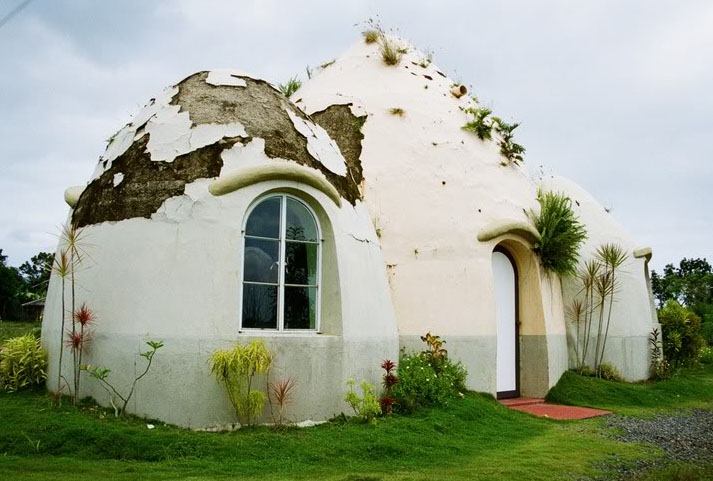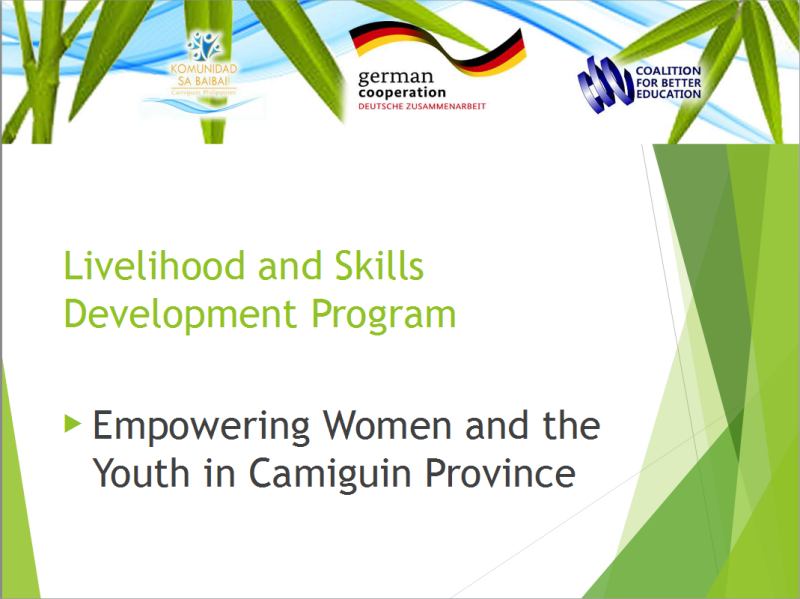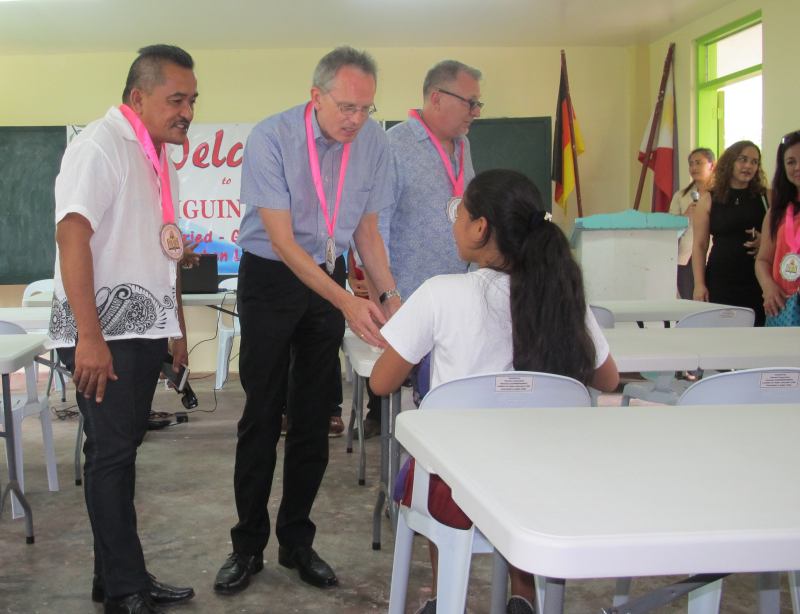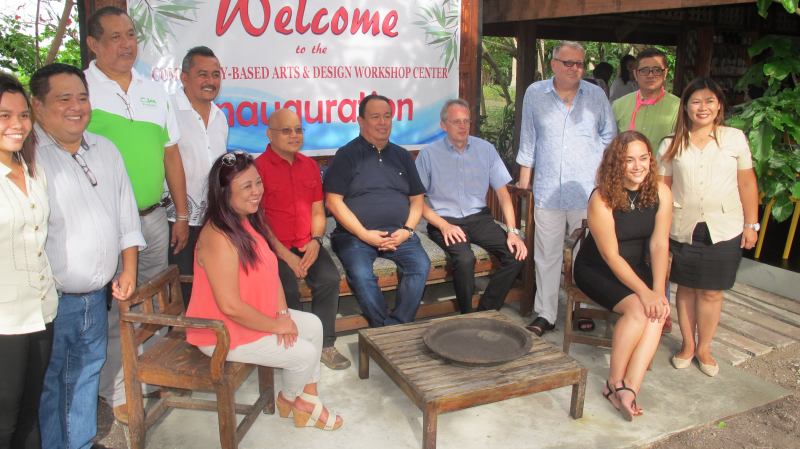Two tightly linked Community Projects with a bright future on Camiguin Island

Yesterday afternoon two tightly linked Community Projects were officially inaugurated in Yumbing and Agoho on Camiguin Island.
Community Projects – Komunidad sa Baibai
We already wrote about the Kumindad sa Baiabai project a week ago. This project with a workshop inside the Balai sa Baibai resort is one of the two linked projects inaugurated yesterday afternoon.
Bright future vs. no future
In the title I wrote ” … Projects with a bright future … “. Why? In my now ten years here in the Philippines I saw many good ideas and many good projects crashing within some months or a few years. The reasons for these unfortunate crashes were almost everywhere the same:
- The good idea came from abroad
- The money came from abroad
- The initial management came from abroad
Filipinos are extremely open and enthusiastic for new ideas. Impatiently they cannot wait to start. And if money flows in from abroad, even the government welcomes almost any project with open hands (hmm, open doors). These projects are rather quickly brought to the launch day and operation. As long as the foreign project managers and specialist are on-site, these projects thrive like Hibiscus under the first sun rays.
When the initial project is ending and management and responsibilities are handed over to locals, the slow but almost sure decease begins. Why? It lacks of supervision, it lacks on management know-how and often technical knowledge is missing. The worst problem is that in Filipino culture proactive maintenance is unknown. Another particularity of the Filipino culture is the weird relationship to money. Budgeting and saving are mostly lacking knowledge.

The Earthbag Clinic in the Philippines failed!
Community based multi tier
The two linked projects in Yumbing and Agoho look much differently.
- The ideas came from within the community
- The money came from abroad and from the Philippines
This multi tier financing creates no dependency of one source - The project is supported by Komunidad sa Baibai, German Cooperation and Coalition for better Eductaion
- The managers and supervisors are Pinoys/Pinays, with only one exception.
This leaders had been trained abroad and understand the scopes of the projects - The projects earn money from the first day. Break-even will be reached within months
Long before the two Community Projects were officially launched, a vigorous training gave the local managers and supervisors the needed knowledge and self-confidence. The acquired language competence is a useful side-effect. A rather small prototype-project, the Camiguin Seaglass , had been launched over a year ago. This small scale pilot project allowed all parties a safe learning without any pressure. Errors could be eradicated , crafting skills were improved and hardware flaws could be improved. In this time also the two workshops were either build or transformed.
The School-based Workshop Center
The School-based Workshop Center is open to all students of the Yumbing National High School.
Yesterday, the first workshop to be opened in a ceremony is within the Yumbing National High School. Guest were welcomed with music and dances. The workshop is a light flooded former class room on second floor. 5 rather short speeches gave this moment ceremonial touch. Mrs Luchi Flores, Executive Director, explained the project’s scope and expected impact with a slide show. Afterwards Leaders, politicians and a member of the German embassy, Mr. Thorsten Gottfried, First Secretary Cultural Affairs, could follow the practical work of embroideries with their own eyes.
The Executive Director’s, Mrs Luchi Flores’, presentation: The full presentation in PowerPoint format is here.
Embroideries have been chosen because of their high part of skills/creativity and their low raw material and tools costs.
Mr Cocoy Bajuyo, Technical Head of KsB, Mr. Thorsten Gottfried, First Secretary Cultural Affairs of the German embassy and Mr. Elden Chamberlain, Chair of Balai sa Baibai and Komunidad sa Baibai
The Community-based Workshop Center
The second venue yesterday afternoon was the Community-based Workshop Center located within the premises of the Balai sa Baibai resort on the sandy beach in Agoho. This workshop center has four tasks: Instruction in seaglass jewelery conception and creation – the making of the jewelery – the intercultural encounters between tourists/guests and local creatives – the principal sales point and cultural gift shop.
Mr Cocoy Bajuyo showed the treasures to the guests of the opening ceremony. In the workshop we could examine the raw seaglass, the tools and the exhibition. With a smile on his lips, Mr Cocoy Bajuyo, showed us his most precious findings in a box labeled antiquities. The official ceremony ended with the unveiling of the second commemorative plate outside of the workshop.
Unveiling of the memorial plate
“Family photo” – no, that’s the official one …
…this is the “real family” photo
Some “seaglass experts to be” …
… and the real seaglass experts checking Cocoy’s antique treasures
Balai sa Baibai guests from Japan surprised us with their traditional outfit (… the men preferred rather convenient dresses)
Do you remember her?
She had been my assistant photographer. I wish her and the two Community Projects a bright future.
[GARD]



















Hi, thanks for this very informative blog. I’m currently conducting research on the energy sources of Camiguin. I was referred to your site by a YouTube blogger named “Expat in the Philippines”. Would you know: what are the power sources in Camiguin? Does it source power from Cagayan de Oro? Is/was there an operational hydro powerplant there? What are the planned power sources for the island? I believe a diesel power plant is operational at the moment, operated by King Energy Generation, Inc. (KEGI).
Thanks a lot. I would love to hear your insights. You can also email me at raf.ignacio@gmail.com
Hi Raf,
The main power source for Camiguin is the STEAG coal power plant in Villanueva, Misamis Oriental.
The KEGI Diesel power plant in Balbagon, Camiguin is now operational. But it is too small to supply power for the whole island.
There are at least some 4 or 5 private solar power installations between 1 and 10 kW. 3 of them are here in Agoho.
Government speaks about a planned solar power plant in Sagay. But up to now, it’s only words.
Cheers, waebi
Thanks for the information. This is really helpful for my research. I hope you don’t mind if I ask a few more questions:
1. Which entity sells the power that comes from STEAG? Is it CAMELCO? I imagine the price of electricity must be very high. Are the consumers able to afford the cost of power?
2. Are there any discussions on establishing a hydro power plant in Camiguin? I believe there is a PSALM hydro power plant in Camiguin but it often has trouble during the summer months. Are there any identified hydro power sites on the island? Are there any ongoing feasibility studies for hydro?
3. Would you know the names of the companies that run the solar power installations? Do they sell to CAMELCO?
4. What do you think will be the future of power in Camiguin? What type of power would be most appropriate, affordable, and sustainable?
Again, thank you so much for your time. I’m very grateful for your insights.
Raf
Hi Raf,
That’s a big load of questions. I copy them in my answer.
1. Which entity sells the power that comes from STEAG? Is it CAMELCO? I imagine the price of electricity must be very high. Are the consumers able to afford the cost of power?
RE: Yes it is CAMELCO and yes, it is very expensive. Generation charge is PHP 5.9998 per kWh. With all the other charges 1 kWh costs the consumer PHP 15.53!
2. Are there any discussions on establishing a hydro power plant in Camiguin? I believe there is a PSALM hydro power plant in Camiguin but it often has trouble during the summer months. Are there any identified hydro power sites on the island? Are there any ongoing feasibility studies for hydro?
RE: I do not have any knowledge of such projects or plans.
3. Would you know the names of the companies that run the solar power installations? Do they sell to CAMELCO?
RE: Yes, Mr. Christian Bolz sells his surplus during the day.
4. What do you think will be the future of power in Camiguin? What type of power would be most appropriate, affordable, and sustainable?
RE: It is clearly solar power. My own installation produced enough power even during the last 3 cloudy months.
I once calculated that in rural houses, where one usually finds 1 light bulb plus 1 outlet for a TV set and cellphone charging, a 250 W panel
with a 80 Ah battery and a 500 W inverter would be sufficient.
With 1,000 standardized installations the investment would be around PHP 10,000 per installation. Break-even could be reached within 2 years.
New LED technology further decreases the electrical consumption. With the same consumption one can run today 4 bulbs directly at 12 Volts DC.
And even more appliances like amplifiers and LED TV sets can also be powered with 12 V DC. This would eliminate the investment and the loss
of the inverter.
Cheers, waebi
Hi Waebi,
Again, thank you so much for the information. I really appreciate the time and effort you put into answering. Maraming salamat!